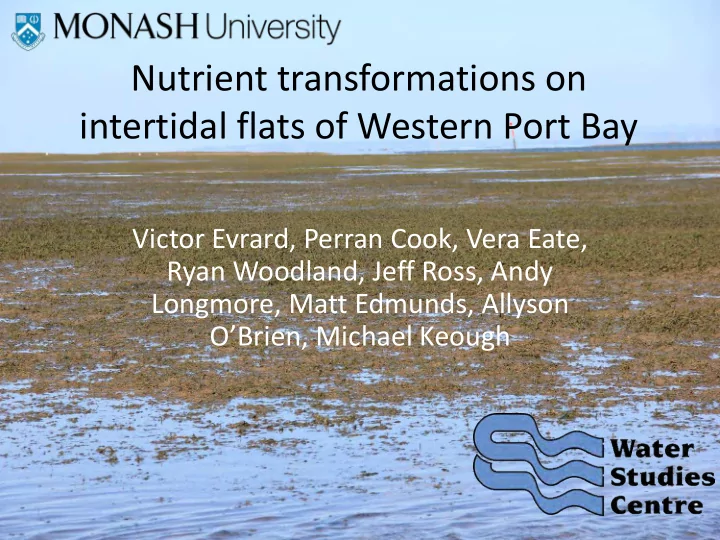

Nutrient transformations on intertidal flats of Western Port Bay Victor Evrard, Perran Cook, Vera Eate, Ryan Woodland, Jeff Ross, Andy Longmore, Matt Edmunds, Allyson O’Brien, Michael Keough
Recommendations from the WP review
Why do we care about nutrients? • Nitrogen and phosphorus are key plant limiting nutrients in aquatic environments • Too many nutrients can lead to algal blooms and seagrass loss • Nutrients are also essential to ecosystem productivity • An understanding of nutrient cycling in Western Port is essential to sound management
Conceptual diagram Catchment inputs N 2 fixation? N 2 production Exchange with Bay Sediment exchange Groundwater? Porewater drainage
Key Questions • What is the exchange of nutrients between the tidal flats and Western Port Bay? • Do tidal flats attenuate nutrient loads from the catchment? • Does nutrient cycling and exchange vary between habitats? • How do fauna interact with cycling processes? • Role of groundwater input?
What we did • Measured large scale exchange between two inlets (dominated by intertidal) and Western Port Bay. Watson Inlet and Chinaman’s inlet (Nov and Feb) • Quantified denitrification and nutrient exchange between the sediment and the water column in 4 key biofacies. Channel, unvegetated intertidal, seagrass intertidal, mangrove intertidal • Sampled flora and fauna to investigate interaction between flora and fauna and processes and measure isotope ratios • Measured Rn concentrations to gauge the importance of groundwater inputs and porewater drainage in exchange processes
Western Port Bay
Study sites
Habitat types
Watson Inlet
Whole system flux calculation With inflow + kg/d NOx Kg/d FRP kg/d NH 4 Nov-11 Load from 4 280 41 WC WI Export 37 350 47
Whole system flux calculation Without inflow + kg/d NOx Kg/d FRP kg/d NH 4 Nov-11 CI 6.7 -17.0 -0.8 Feb-12 WI -8.8 -2.3 -15.2 CI 9.4 -6.7 -0.5
How do processes vary with habitat type?
Denitrification rates in different habitats 250.00 200.00 150.00 Seagrass Mangrove Bare 100.00 Channel 50.00 0.00 CI dark CI light WI dark WI light
Why is denitrification so high in bare sediment? Image Courtesy of the Museum of Victoria, photo by Gary Poore
How do whole system and scaled habitat rates compare? Nutrient Scaled habitat kg/d Whole system kg/d Watson Inlet NH 4 + 27 -9 NOx -12 -2 FRP -3 -15 Chinaman Inlet + NH 4 8 9 NOx -5 -7 FRP -1 -0.5
Stable isotopes – what can they tell us? • Elements often have a heavy and a light form • Carbon and nitrogen are such elements • In primary producers (e.g., seagrass) the heavy/light ratio can tell us about their nitrogen sources and photosynthesis • In animals, the heavy/light isotope ratio can tell us what they are eating
Where does seagrass get its nitrogen? Nitrogen source Atmosphere Marine Human Chinaman Inlet Watson Inlet Heavy Light Isotope scale ~80% from nitrogen fixation ~20% from Watson Creek
What are the fauna eating?
Food sources for B. arenosus
How does denitrification and nitrogen fixation compare to N loads for the whole Bay? • Assuming the area of Northern Western Port is 70 km 2 and scaling up the rates measured in this study (~10 g N m -2 y -1 ), then the annual rate of denitrification is ~700 tonnes N per year • This compares to an estimated annual average load of 600 tonnes per year to Western Port • Using literature measurements of N 2 fixation rates, the whole bay fixes ~200 tonnes of N per year. Bay is roughly in balance!
Conceptual diagram Catchment inputs N 2 fixation N 2 production Exchange with Bay Phosphorus Porewater drainage
Recommend
More recommend